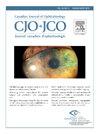通过远程眼科推进眼部肿瘤治疗:以患者为中心的视角。
IF 2.8
4区 医学
Q1 OPHTHALMOLOGY
Canadian journal of ophthalmology. Journal canadien d'ophtalmologie
Pub Date : 2024-08-03
DOI:10.1016/j.jcjo.2024.06.005
引用次数: 0
摘要
目的:评估患者满意度是了解项目疗效和质量的重要组成部分。本研究旨在评估患者对远程眼科项目的满意度,该项目为眼部肿瘤学量身定制,提供筛查、远程评估、护理计划和随访服务,并评估其在满足患者医疗保健需求方面的有效性:研究设计:回顾性调查:采用改编版远程医疗满意度量表对患者进行调查,该量表由 8 个问题和 5 个针对远程眼科项目的附加问题组成。远程眼科项目包括诊断成像、远程医生评估和医疗团队成员的后续电话,以便向患者提供结果。在报告方面,采用了基于共识的调查研究报告核对表:在所联系的 95 名患者中,有 91 人同意参与调查(回复率为 96%)。参与者对远程眼科项目的总体满意度很高,远程医疗满意度量表的平均值为 28.88(SD = 3.35,共 32 分)。远程眼科就诊次数的中位数为 4.0 次(1-8 次不等)。T 检验探讨了不同人口统计学特征和远程眼科就诊次数之间的满意度差异。在年龄(P = 0.56)、城乡居住地(P = 0.17)或远程医疗预约次数(P = 0.51)方面未发现明显差异:这项分析表明,无论年龄、地域或远程眼科就诊次数如何,参与当前远程医疗项目的眼部肿瘤诊所的患者对项目的满意度都很高。参加者表示,由于远程会诊和电话沟通,他们只需很少的临床接触就能满足自己的医疗保健需求。本文章由计算机程序翻译,如有差异,请以英文原文为准。
Advancing ocular oncology care through teleophthalmology: a patient-centric perspective
Objective
Assessing patient satisfaction is an important component of understanding a program's efficacy and quality. The purpose of this study is to evaluate patient satisfaction with a teleophthalmology program tailored for ocular oncology that provides screening, remote assessment, care planning, and follow-up.
Study design
Retrospective survey.
Methods
An adapted version of the Telehealth Satisfaction Scale, consisting of the 8 questions plus 5 additional questions specific to the teleophthalmology program, was used to survey patients. The teleophthalmology program involves diagnostic imaging, remote physician assessments, and follow-up phone calls from health care team members to deliver results to patients. For reporting, the Consensus-Based Checklist for Reporting of Survey Studies was used. T-tests explored satisfaction differences across demographics and teleophthalmology visits.
Results
Among the 95 patients contacted, 91 agreed to participate in the survey (96% response rate). Participants exhibited high overall satisfaction with the teleophthalmology program, reflected in a mean Telehealth Satisfaction Scale score of 28.88 (SD = 3.35 of 32). The median number of teleophthalmology visits completed was 4.0 (range of 1–8 appointments). No significant differences in satisfaction were found on the basis of age (P = 0.56), urban or rural residence (P = 0.17), or the number of telemedicine appointments (P = 0.51).
Conclusions
This analysis displays high satisfaction levels among patients within an ocular oncology clinic participating in the current telemedicine program, irrespective of age, geography, or number of teleophthalmology visits. Participants reported having their health care needs met with minimal clinical encounters due to remote consultations and telephone communications.
Objectif
L’évaluation de la satisfaction des patients est importante pour comprendre l'efficacité et la qualité d'un programme donné. Notre étude avait pour objectif d’évaluer la satisfaction des patients envers un programme de téléophtalmologie adapté pour l'oncologie oculaire qui assure le dépistage, l’évaluation à distance, la planification des soins et le suivi.
Nature
Sondage rétrospectif.
Méthodes
On a eu recours à une version adaptée du questionnaire de satisfaction sur la télémédecine (Telehealth Satisfaction Scale; TeSS) comprenant les 8 questions d'origine et 5 questions supplémentaires sur le programme de téléophtalmologie, lequel incluait l'imagerie diagnostique, les évaluations à distance par les médecins et les appels téléphoniques de suivi de la part des membres de l’équipe soignante pour la transmission des résultats aux patients. On a fait appel à la méthodologie CROSS (Consensus-Based Checklist for Reporting of Survey Studies) pour réaliser notre compte-rendu. Les tests t examinaient les différences au chapitre de la satisfaction en fonction des données démographiques et des visites de téléophtalmologie.
Résultats
Sur les 95 patients qui ont été contactés, 91 ont accepté de répondre au sondage (taux de réponse de 96 %). Dans l'ensemble, les participants étaient grandement satisfaits du programme de téléophtalmologie, ce qui s'est traduit par un score moyen de 28,88 (écart-type : 3,35 sur 32) sur l’échelle TeSS. Le nombre médian de visites de téléophtalmologie se chiffrait à 4,0 (fourchette de 1 à 8 visites). Aucune différence significative en ce qui a trait à la satisfaction n'a été enregistrée en fonction de l’âge (p = 0,56), de la résidence en milieu urbain ou rural (p = 0,17) ou du nombre de rendez-vous en téléophtalmologie (p = 0,51).
Conclusions
Notre analyse fait ressortir un degré élevé de satisfaction de la part des patients de la clinique d'oncologie oculaire inscrite au programme de télémédecine, sans égard à l’âge, aux caractéristiques géographiques ou au nombre de rendez-vous en téléophtalmologie. Les besoins en matière de santé des participants ont été comblés par un minimum de rencontres en clinique grâce aux consultations à distance et aux communications téléphoniques.
求助全文
通过发布文献求助,成功后即可免费获取论文全文。
去求助
来源期刊
CiteScore
3.20
自引率
4.80%
发文量
223
审稿时长
38 days
期刊介绍:
Official journal of the Canadian Ophthalmological Society.
The Canadian Journal of Ophthalmology (CJO) is the official journal of the Canadian Ophthalmological Society and is committed to timely publication of original, peer-reviewed ophthalmology and vision science articles.

 求助内容:
求助内容: 应助结果提醒方式:
应助结果提醒方式:


